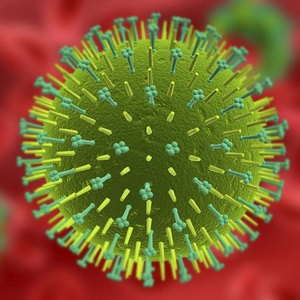Jun. 27, 2008 Research Highlight Biology
Interferon production mechanisms revealed
Researchers are a step closer to understanding the mechanisms underlying a major immune defense against viruses
 Figure 1: Infection with a virus can trigger production of type I interferons in the body’s first line of defence.
Figure 1: Infection with a virus can trigger production of type I interferons in the body’s first line of defence.
RIKEN researchers based at the RIKEN Research Center for Allergy and Immunology in Yokohama have unraveled part of the mechanism for the production of type I interferons by immune system cells known as plasmacytoid dendritic cells (PDCs).
PDCs are specialized producers of type I interferons: proteins, produced in response to viral and other infections, which play an important role in the so-called innate immune response, which is the body’s first line of defense against infection (Fig. 1). Type I interferons, including IFN-α and IFN-β, rapidly act to inhibit viral replication within infected cells, giving the infected host time to marshal a full immune response. But the mechanisms underlying interferon production are poorly understood.
Now, the research team, led by Masaru Taniguchi, has identified a protein on the surface of PDCs that is expressed after stimulation through the so-called toll-like receptor (TLR) pathway1. TLR is known to be required to activate interferon production in PDCs, but previous studies have shown that signaling through TLR is not the only trigger for interferon production.
The researchers demonstrated that the protein, known as PDC-TREM, was associated on the PDC cell surface with at least two other proteins, Plexin A1 and DAP12. Under the condition of limited TLR stimulation, PDC-TREM was expressed on PDCs, but interferon production was not triggered.
However, when TLR stimulation took place in the presence of a protein that binds to Plexin A1, known as Sema6D, interferon was produced. Further investigation revealed that PDC-TREM mediated the activation of a cascade of signaling molecules that ultimately up-regulated the production of IFN-α.
Finally, the team demonstrated that inhibition of PDC-TREM expression, blocking of its binding to Plexin A1, and DAP12 deficiency all resulted in significantly reduced activation of these signaling molecules and subsequent production of IFN-α.
According to team-member Hiroshi Watarai, the results clearly demonstrate that PDC-TREM plays a central role in inducing interferon production in PDCs, which may provide possibilities for treatment of viral infections and other diseases in which interferon plays a role.
“Serum in patients with autoimmune diseases such as systemic lupus erythmatosus and Crohn's disease contains high level of type I interferons,” notes Watarai. “These results indicate that modulation of PDC-TREM signaling results in the regulation of type I interferon production from PDCs, so the PDC-TREM pathway may be a target for therapeutic use in anti-viral and autoimmune diseases.”
References
- 1. Watarai, H., Sekine, E., Inoue, S., Nakagawa, R., Kaisho, T. & Taniguchi, M. PDC-TREM, a plasmacytoid dendritic cell-specific receptor, is responsible for augmented production of type I interferon. Proceedings of the National Academy of Sciences USA 105, 2993–2998 (2008). doi: 10.1073/pnas.0710351105
